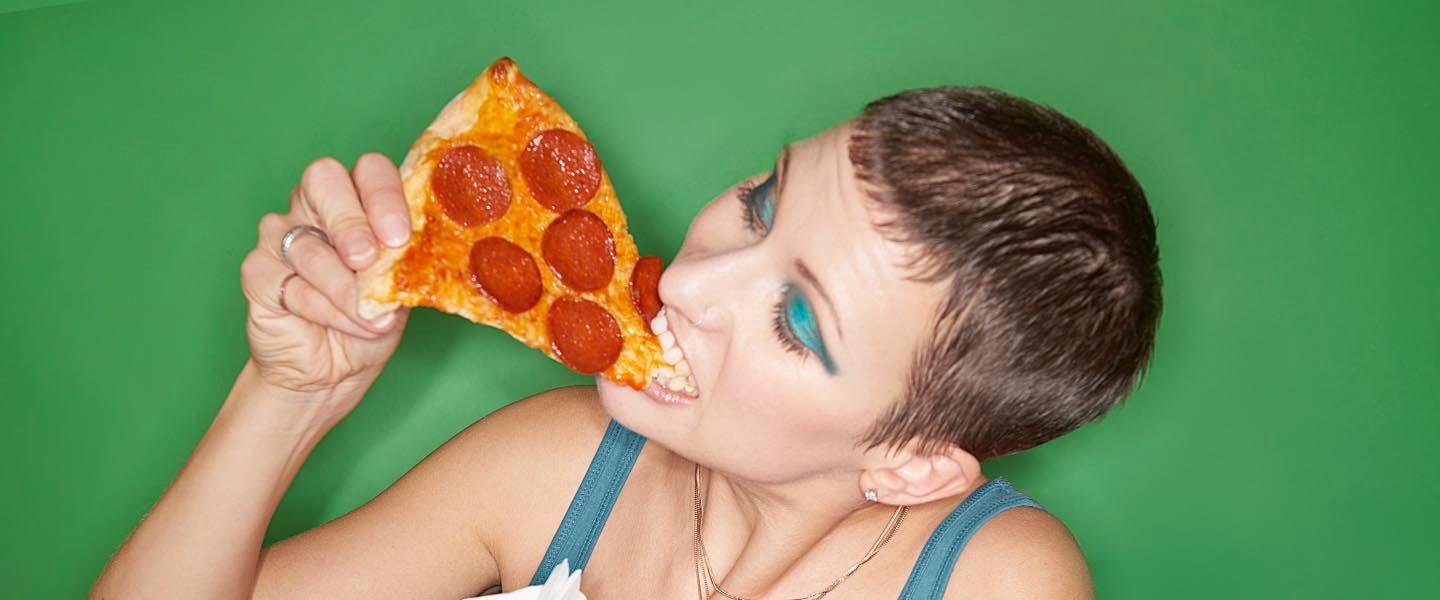Men are often impressed when Eliza, a petite artist in her 30s who grew up in the Seattle area, orders a burger in their presence. “I’ve always received approving commentary only from men any time I eat a lot or eat ‘unhealthy’ food around them,” she says. “It’s always framed as patronizing, sexualized or both. Old men love to say things like, ‘I like a girl that can eat!’” Eliza knows, however, that this approval depends on her having “always been thin,” and that if she was bigger, the reaction would veer toward disapproval or disgust — a suspicion Emily, a 28-year-old AV technician based in Texas, confirms. “I’ve been a variety of sizes,” she says, “and men will either look at me with pride or disgust when I glibly say, ‘No, I won’t be sharing these nachos with you,’ depending on whether I’m thin or thick.”
The idea that men are attracted to women with vociferous appetites who chow down on meat, junk food and beer — on the strict proviso that they remain thin — is now a cultural mainstay. It’s an attitude summed up in a comment my colleague Steph Mitesser saw recently on a man’s dating profile — “I want a woman who loves to eat pizza but doesn’t look like she loves to eat pizza” — and it’s evident when young, conventionally attractive celebrities caption their Instagram selfies with longings for pasta and pizza, a trend the feminist satire website Reductress parodies in an article called “I Love Pizza, Which Is Adorable Because I’m Hot.”
“Any gal can eat a salad or Instagram a picture of green juice,” the article jokes, “but me? I prefer to show that I’m just a girl next door, who likes greasy food and doesn’t give a hoot if anyone knows it!”
It hasn’t always been this way. Throughout the 20th century, women were encouraged to demonstrate their delicate sensibilities by choosing “dainty” options like salad and soup and by portraying themselves as having a limited appetite — and conversely, a vociferous appetite had to be hidden. “Conventional dating wisdom for women was to eat something at home alone before a date,” The New York Times reports, “and then in company order a light dinner to portray oneself as dainty and ladylike.” During the second half of the 20th century, stick-thin supermodels like Twiggy and Kate Moss were the dominant image of female attractiveness, and Moss’ infamous phrase, “Nothing tastes as good as skinny feels,” sums up the 1990s approach to body image issues.
By the 2000s, though, the tide was shifting in favor of women who displayed a cavalier attitude toward calories — while still remaining thin, of course. “Salad, it seems, is out,” author Allen Salkin declared in The New York Times in 2007, while “gusto, medium rare, is in.” Speaking to restaurateurs and women on the New York dating scene, he found that calorie-conscious options like salad were being described as “wimpy, insipid and childish,” whereas women were ordering red meat and burgers as part of a strategy to appear “unpretentious, down-to-earth and unneurotic.” One source said ordering red meat demonstrates that she’s “not obsessed with my weight even though I’m thin, and I don’t have any food issues,” whereas burgers signal that she’s “a cheap date, low maintenance” — an axiomatically good thing for a woman to be, apparently, if your sole objective is to land a boyfriend.
In other words, by the turn of the century, women were expected to be “cool girls,” as articulated by Gillian Flynn in the famous “Cool Girl Manifesto” passage of her 2012 novel, Gone Girl. “Men always say that as the defining compliment, don’t they? She’s a cool girl,” she writes. “Being the Cool Girl means I am a hot, brilliant, funny woman who adores football, poker, dirty jokes and burping, who plays video games, drinks cheap beer, loves threesomes and anal sex and jams hot dogs and hamburgers into her mouth like she’s hosting the world’s biggest culinary gang bang while somehow maintaining a size 2, because Cool Girls are above all hot.”
The Cool Girl was well represented on TV and in movies, celebrity culture and advertising during this time, and her attitude toward food was a key signifier of her “chill.” Jennifer Lawrence, who has made a cutesy love of food part of her personal brand and who says she “can name a lot of things that taste better than skinny feels,” is a quintessential example, as are Lorelai and Rory of Gilmore Girls, whose diets are “basically a long list of everything you’re supposed to eat in moderation,” Liz Lemon of 30 Rock and the women in Carl’s Jr.’s “slutburger” ads, who mouthed giant cheeseburgers in size zero bikinis.
But for fat women, being the Cool Girl was never an option. When they eat with the same abandon encouraged in thin women, they’re more likely to encounter chiding, moralism and disgust, as Emily attests. A second Emily, a 35-year-old customer support worker in Chicago whose weight has also fluctuated throughout her life, says that when she’s bigger, boyfriends often suggest she order the salad option or “gently” encourage weight loss. “Gender stereotypes [like the Cool Girl] are only for thin women to interact with,” she explains. “Fat is a totalizing identity in the context of food.” Because most women are not thin, they’re expected not to behave like Cool Girls, and the old dictate to eat dainty food on first dates still largely applies: According to research from Aarhus University in Denmark, women are more likely to eat low-calorie options around men to whom they’re attracted to.
It’s clear from the different attitudes toward thin and fat women who eat with the abandon of the Cool Girl that the character never represented a departure from mainstream beauty standards. In the 1980s, 1990s, 2000s and even ostensibly “body positive” 2010s, women were and are expected to be thin, give or take a bolt-on boob job or ass injections. Not to mention, the celebrities portrayed as most beautiful — whether the waifish Kate Moss or “curvy” Kim Kardashian, who has a 24-inch waist and is, in fact, tiny — are often a size that’s unachievable for most women without extreme, miserable dieting. And while some women don’t need to diet to remain thin, for many with the “ideal” body type, extreme, miserable dieting is exactly what it takes. Just ask the runway models popping laxatives, eating cotton balls to feel full and subsisting on just an apple a day.
This is all a huge bummer, which is why men prefer not to think about it. “I definitely think the ‘hot, thin girls eat food’ thing is a combination of men’s desire for an attractive woman and the disgust or disinterest in seeing any of the work women do to make themselves attractive,” says Rachel, a 32-year-old marketer in Wisconsin. “Much in the way that a 1950s husband might prefer his wife to be fully made up in a dress when he sees her.” As Rachel suggests, the pressure to be the perfect woman and to make it look effortless is decades old. “As [Schrafft’s founder] Frank Shattuck observed in the 1920s, a young man contemplating marriage is looking for a girl who is a ‘good sport,’” Paul Freedman writes for The Conversation. “A husband doesn’t want to come home to a bedraggled wife who has spent all day at the stove. Yes, he wants a good cook, but he also wants an attractive, ‘fun’ companion.”
This “almost impossible ideal” is echoed in the Cool Girl, who fulfills men’s desire for a thin woman while also placating his aversion to the often dull and depressing reality of maintaining a slim figure. Or as Rachel puts it, “She’s thin, but I don’t have to consider or be inconvenienced by what she might have to go through to be thin.”

